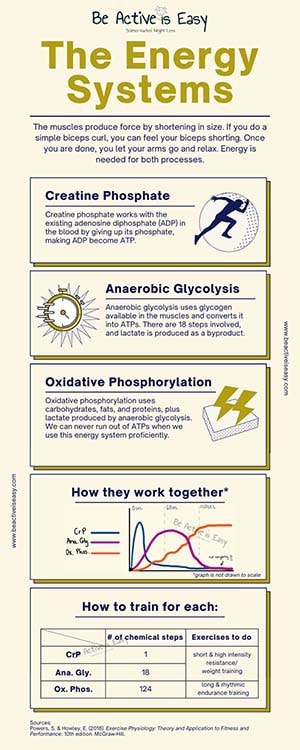The energy systems in the body – explained
I have talked about how to start exercising, get a good night’s sleep, and eat right. Now let’s talk about the energy system that helps the body function.
Are you wondering how your body uses energy? I mean, we eat food every day to get energy, but how do we use them? Primarily how our muscles utilize the energy systems in the body.
Knowing this knowledge can help you achieve your health goals much easier. Training for a 5K and deadlifting 200 pounds will require different types of exercise.
Buckle in for a ride! Cause you are going to need your energy through this blog o(* ̄▽ ̄*)
Summary
How do the muscles produce force?
The muscles produce force by shortening in size. If you do a simple biceps curl, you can feel your biceps shorting and maybe becoming more prominent. Once you are done, you let your arms go and relax. And energy is needed for both processes.
That is why our bodies go stiff temporarily after passing because there would be no more energy supplied for the muscles to relax.
The name of this type of energy is adenosine triphosphate or ATP. Our bodies store a limited amount of potential ATP in the bloodstream, but it goes out pretty quickly, using the Creatine Phosphate system. But we need even more energy to live simply for our daily lives or for exercise purposes. Hence, there are two other energy systems for the body to generate its power.
Creatine Phosphate
Creatine phosphate is the first energy system in the body we are going to talk about. It is the most rapid way for the muscles to get access to ATP. Because of its fast speed, this system can go out of steam quickly as well, usually within the first 10 seconds of your workout. Imagine Usain Bolt mostly uses this energy system for his insanely fast sprints.
The way this energy system works is very straightforward. Creatine Phosphate donates its one phosphate molecule to adenosine diphosphate (ADP) to make ATP. And ATP is what we need. The leftover product would be creatine. One step one kill! No need for extra oxygen.
Creatine phosphate is replenished quickly as well. It only takes about 5 minutes of complete rest for the body to get back to its full amount of creatine phosphate.
Anaerobic Glycolysis
Coming next in our second energy system in the body is anaerobic glycolysis. True to its name, this energy system does not use any oxygen. It also supports high-intensity exercises. Despite this, anaerobic glycolysis in an energy system in the body that can be dominantly for – wait for it – 1 → 2 minutes!!! (๑•̀ㅂ•́)و✧ That is way more than creatine phosphate, amirite?
As the name intents, anaerobic glycolysis uses glycogen to produce ATP. It does make more ATPs than creatine phosphate does, but it does produce lactate as a byproduct. There are 18 steps involved in this process. Many think this lactate makes you feel sore the next day after an exercise, but it has not been formally concluded. But this lactate can produce more ATPs in different organs for the next energy system in the body!
When do we use this energy system? Anything high in intensity and a short amount of time. Think about the 800m dash, not exactly done in 10 seconds but no longer than 5 minutes.
Oxidative Phosphorylation
This is the most powerful (or OPed in Gen Z terms) energy system in the body. Basically, we can never run out of ATPs when we use this energy system proficiently. Why is it so strong? Because it needs oxygen and the most complicated chemical chains of all!
Remember all the macronutrients in our diet? Oxidative phosphorylation uses all of them, plus the lactate produced by anaerobic glycolysis. And as expected, this energy system goes through a whopping 124 steps! Taking the most time out of all three energy systems. This energy system is beneficial for endurance training. Imagine running a full marathon of 26.2 miles (or 42.20 km) in a day. You will need a lot of ATPs to sustain yourself and make it to the finishing line.
The energy systems in the body – how to train?
Now that we are family with each energy system in the body! What do you think about them? Amazing? Marvelous?
During exercise, all THREE systems work together in tandem. As one might dominate over the other, but they never work alone.
I have made a quick little summary down here to remember and know which exercises to focus on for each energy system in the body. ↓↓

Sources (note: I am citing from textbooks and research papers for this one since the subject is much more in-depth than my usual blog)
Doyle, A. (2019). Lecture 4: Creatine Phosphate [PowerPoint Slides]. Georgia State University Physiology of Exercise: https://gsu.edu
Doyle, A. (2019). Lecture 5: Anaerobic Glycolysis [PowerPoint Slides]. Georgia State University Physiology of Exercise: https://gsu.edu
Doyle, A. (2019). Lecture 7: Oxidative Phosphorylation [PowerPoint Slides]. Georgia State University Physiology of Exercise: https://gsu.edu
Powers, S. & Howley, E. (2018). Exercise Physiology: Theory and Application to Fitness and Performance. 10th edition. McGraw-Hill.

